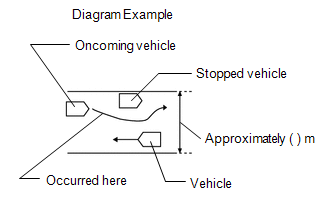Toyota CH-R Service Manual: How To Proceed With Troubleshooting
CAUTION / NOTICE / HINT
HINT:
- Use these procedures to troubleshoot the pre-collision system.
- *: Use the Techstream.
PROCEDURE
|
1. |
VEHICLE BROUGHT TO WORKSHOP |
|
|
2. |
CUSTOMER PROBLEM ANALYSIS AND SYMPTOM CHECK |
|
Pre-collision System Customer Problem Analysis |
Vehicle Brought to Workshop |
||||||
|---|---|---|---|---|---|---|---|
|
Year |
Month |
Day |
|||||
|
Dealer name |
Person in charge at headquarters |
Telephone number |
|||||
|
Shop name |
Person in charge at shop |
||||||
|
Frame type |
Frame No. |
First Registered Year |
Total distance traveled |
||||
|
Customer Concerns (Include details) |
Does not operate |
||||||
|
Operates abnormally |
|||||||
|
Date of malfunction occurrence (Since when) |
Year |
Month |
Day |
Approx. Time |
|||
|
Date of last inspection |
Year |
Month |
Day |
||||
|
Frequency of problem symptoms |
Once / Occasionally (times per day, times per month) / Every time certain conditions are met ( ) |
||||||
|
Weather |
Sunny / Cloudy / Rain / Snow (Amount of snowfall cm) / Other ( ) |
Vehicle speed |
Approximately ( ) km/h |
||||
|
Place |
Prefecture (Attach a map if possible) |
||||||
|
Driving path (where vehicle turned, where driver attempted to drive to, etc.) * Describe the conditions immediately after the occurrence in as much detail as possible. |
Conditions of Occurrence Diagram  |
||||||
 |
|||||||
|
Surrounding road conditions Describe whether there were any billboards, metal objects on the road (manholes), guardrails, pipes, cat's eyes, gate bars, etc. |
|||||||
|
Urban area / Suburbs / Highway / Other ( ) |
Road surface conditions |
Temperature |
About °C ( °F) |
||||
|
Direction of travel |
Straight / Right turn / Left turn / Right curve / Left curve |
Snow wall(s) |
Y / N |
||||
|
Driving lane |
Number of lanes on one side (lanes) / ( ) lane(s) from left |
Backlighting |
Y / N |
||||
|
Condition of external area around detection sensor |
No foreign matter / Foreign matter (water, snow, ice, other) |
||||||
|
Additional information about condition of vehicle exterior (other than above) |
|||||||
|
DTC |
First Time (when vehicle brought to workshop) |
||||||
|
Second Time (after clearing DTC) |
|||||||
|
Status of operation switch |
Pre-collision system cancel switch |
Far / Medium / Near / OFF |
VSC OFF switch |
ON / OFF |
|||
|
Serial number of main part * Fill in when removing, installing or replacing part |
Forward recognition camera |
||||||
|
Describe the items to the right in as much detail as possible. |
Driver operation |
Accelerator pedal operated / Brake pedal operated / Steering wheel operated |
Time elapsed after engine was started |
Approximately ( ) minutes |
|||
|
Tire pressure inspection result |
Front: LH ( ) kPa RH ( ) kPa Standard ( ) kPa |
||||||
|
Rear: LH ( ) kPa RH ( ) kPa Standard ( ) kPa |
|||||||
|
Sensor optical axis inspection result |
Forward recognition camera |
Accident history |
Y / N |
||||
|
Millimeter wave radar sensor assembly |
Accident history |
Y / N |
|||||
|
Vehicle modified |
Y ( ) / N |
||||||
|
Items installed or attached around windshield glass |
Drive recorder* / Radar detector / Navigation unit (genuine/non-genuine) / ETC / Charms or toys / Other: *: As information regarding the item is important for the investigation, make sure to obtain the item if permission is given by the customer. |
||||||
|
|
3. |
INSPECT BATTERY VOLTAGE |
(a) Measure the battery voltage.
Standard voltage:
11 to 14 V
If the voltage is below 11 V, replace or recharge the battery before proceeding to the next step.
|
|
4. |
INSPECT MILLIMETER WAVE RADAR SENSOR ASSEMBLY (BEAM AXIS MISALIGNMENT READING)* |
(a) Adjust the reflector height.
Click here .gif)
(b) Place the reflector.
Click here .gif)
(c) Connect the Techstream to the DLC3.
(d) Turn the ignition switch to ON.
(e) Turn the Techstream on.
(f) Turn the cruise control main switch on.
(g) Enter the following menus: Body Electrical / Pre-Collision 2 / Utility / Front Beam Axis Misalignment Reading.
(h) Check the amount of misalignment and make a note.
Body Electrical > Pre-Collision 2 > Utility|
Tester Display |
|---|
|
Front Beam Axis Misalignment Reading |
(i) Enter the following menus: Body Electrical / Pre-Collision 2 / Utility / Front Beam Axis Offset Reading.
(j) Check the amount of misalignment and make a note.
Body Electrical > Pre-Collision 2 > Utility|
Tester Display |
|---|
|
Front Beam Axis Offset Reading |
|
|
5. |
CHECK CAN COMMUNICATION SYSTEM* |
(a) Using the Techstream, check if the CAN communication system is functioning normally.
HINT:
Refer to CAN Bus Check in CAN Communication System.
Click here .gif)
.gif)
OK:
CAN communication system is functioning normally.
| NG | .gif) |
GO TO CAN COMMUNICATION SYSTEM |
|
|
6. |
INSPECT WARNING LIGHT |
(a) Check the condition of the warning lights on the combination meter assembly.
|
Result |
Proceed to |
|---|---|
|
Only the PCS warning light is blinking |
A |
|
The PCS warning light is not blinking |
|
|
The PCS warning light and other warning lights are illuminated or blinking |
B |
| B | .gif) |
GO TO MALFUNCTIONING SYSTEM |
|
|
7. |
INSPECT MULTI-INFORMATION DISPLAY |
(a) Check if a pre-collision system warning message is displayed on the multi-information display in the combination meter assembly.
|
Result |
Proceed to |
|---|---|
|
"Pre-Collision System Malfunction Visit Your Dealer" is displayed |
A |
|
Any of the following messages is displayed
|
B |
|
Warning message is not displayed |
C |
| B | .gif) |
GO TO PROBLEM SYMPTOMS TABLE |
| C | .gif) |
CHECK CONDITIONS WHEN PRE-COLLISION SYSTEM DID NOT OPERATE
|
|
|
8. |
CHECK FOR DTCs (PRE-COLLISION SYSTEM) |
HINT:
Refer to DTC Check / Clear.
Click here .gif)
(a) Check for DTCs and note any codes that are output.
Body Electrical > Pre-Collision 2 > Trouble Codes(b) Clear the DTCs.
Body Electrical > Pre-Collision 2 > Clear DTCs(c) Recheck for DTCs.
(1) Attempt to duplicate the malfunction and check if the DTCs are output again.
Body Electrical > Pre-Collision 2 > Trouble Codes|
Result |
Proceed to |
|---|---|
|
Malfunction is duplicated but DTCs are not output |
A |
|
Malfunction cannot be duplicated and DTCs are not output |
B |
|
DTCs are output |
C |
| B | .gif) |
GO TO SYMPTOM SIMULATION |
| C | .gif) |
GO TO DTC CHART |
|
|
9. |
PROBLEM SYMPTOMS TABLE |
HINT:
Refer to Problem Symptoms Table.
Click here .gif)
|
Result |
Proceed to |
|---|---|
|
Fault is not listed in Problem Symptoms Table |
A |
|
Fault is listed in Problem Symptoms Table |
B |
| B | .gif) |
GO TO STEP 12 |
|
|
10. |
OVERALL ANALYSIS AND TROUBLESHOOTING* |
(a) Terminals of ECU
Click here .gif)
(b) Data List / Active Test
Click here .gif)
|
|
11. |
ADJUST, REPAIR OR REPLACE |
NOTICE:
When the millimeter wave radar sensor assembly is replaced with a new one, adjustment of the radar sensor beam axis must be performed.
Click here .gif)
|
|
12. |
CONFIRMATION TEST |
| NEXT | .gif) |
END |
 System Diagram
System Diagram
SYSTEM DIAGRAM
Communication Table
Sender
Receiver
Signal
Line
Millimeter Wave Radar Sensor Assembly
Skid Control ECU (Brak ...
 System Description
System Description
SYSTEM DESCRIPTION
PRE-COLLISION SYSTEM DESCRIPTION
(a) The pre-collision system uses the pre-collision alarm control, pre-collision
brake assist control and pre-collision brake control to help av ...
Other materials:
Toyota CH-R Owners Manual > Using the interior lights: Personal lights
Turns the lights on/off
When the lights are on due to the door link switch, a light will not turn off
even if its switch is pressed.
■Illuminated entry system
Vehicles without a smart key system
When the interior light switch is in the door position, the interior lights automatically
t ...
Toyota CH-R Service Manual > Brake Actuator: Precaution
PRECAUTION
IGNITION SWITCH EXPRESSIONS
(a) The type of ignition switch used on this model differs depending on the specifications
of the vehicle. The expressions listed in the table below are used in this section.
Expression
Ignition Switch (Position)
Engine Swi ...
Toyota C-HR (AX20) 2023-2025 Owner's Manual
Toyota CH-R Owners Manual
- For safety and security
- Instrument cluster
- Operation of each component
- Driving
- Interior features
- Maintenance and care
- When trouble arises
- Vehicle specifications
- For owners
Toyota CH-R Service Manual
- Introduction
- Maintenance
- Audio / Video
- Cellular Communication
- Navigation / Multi Info Display
- Park Assist / Monitoring
- Brake (front)
- Brake (rear)
- Brake Control / Dynamic Control Systems
- Brake System (other)
- Parking Brake
- Axle And Differential
- Drive Shaft / Propeller Shaft
- K114 Cvt
- 3zr-fae Battery / Charging
- Networking
- Power Distribution
- Power Assist Systems
- Steering Column
- Steering Gear / Linkage
- Alignment / Handling Diagnosis
- Front Suspension
- Rear Suspension
- Tire / Wheel
- Tire Pressure Monitoring
- Door / Hatch
- Exterior Panels / Trim
- Horn
- Lighting (ext)
- Mirror (ext)
- Window / Glass
- Wiper / Washer
- Door Lock
- Heating / Air Conditioning
- Interior Panels / Trim
- Lighting (int)
- Meter / Gauge / Display
- Mirror (int)
- Power Outlets (int)
- Pre-collision
- Seat
- Seat Belt
- Supplemental Restraint Systems
- Theft Deterrent / Keyless Entry
0.0081

.gif)